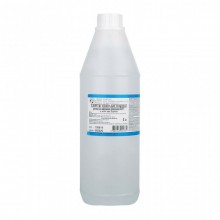



Chlorhexidine has antimicrobial activity in relation to Gram and influenza and other respiratory viral infections), yeast-like fungi of the genus Candida, dermatophytes. Prolonged action - up to 4 hours.
- For local use: trichomonas colpitis, cervical erosion, vulvar itching, prevention of sexually transmitted diseases (including gonorrhea, syphilis, trichomoniasis, chlamydia, ureaplasmosis); gingivitis, stomatitis, afty, periodontitis, alveolitis, disinfection of removable dentures; angina; postoperative nursing care in the ENT and dentistry departments.
-Treatment of wounds, burn wounds and surfaces; disinfection of the patient's skin.
- Processing of the hands of the surgeon, the medical staff and the surgical field before diagnostic manipulations, surgery.
- Disinfection of working surfaces of devices (including thermometers) and equipment, heat treatment of which is undesirable.
1 l. Of a solution for topical and external use contains:
active ingredient: chlorhexidine solution for the preparation of dosage forms 20%
Chlorhexidine is marketed under different brands and generic names, and comes in different dosage forms:
| Brand name | Manufacturer | Country | Dosage form |
|---|---|---|---|
| Chlorhexidine | Rosbio | Russia | vials |
| Chlorhexidine | Tula pharmaceutical factory | Russia | vials |
| Chlorhexidine | Rosbio | Russia | spray |
| Hexicon | Makiz-Pharma | Russia | pills |
| Chlorhexidine | Yuzhfarm | Russia | vials |
| Chlorhexidine | Pharmproject | Russia | suppositories |
| Chlorhexidine | Samaramedprom | Russia | solution |
| Chlorhexidine | Biogen | Russia | vials |
| Hexicon | Nizhpharm | Russia | suppositories |
No customer reviews for the moment.
Hypersensitivity to chlorhexidine.
Possible: allergic reactions.
Chlorhexidine is incompatible with soap and also with detergents containing an anionic group (saponins, sodium lauryl sulfate, sodium carboxymethylcellulose).
Compatible with drugs containing a cationic group (cetrimonium bromide, benzalkonium chloride).
Studies and clinical trials of Chlorhexidine (Click to expand)